AMD Zen 4 Ryzen 9 7950X and Ryzen 5 7600X Review: Retaking The High-End
by Ryan Smith & Gavin Bonshor on September 26, 2022 9:00 AM ESTClosing Thoughts
While AMD has made significant strides with Zen 4 over the previous Zen 3 and Zen 2 microarchitectures, it's time to translate these improvements into actual performance. First of all, our Ryzen 9 7950X boosted up 5.74 GHz on a single-core, which is very impressive. Although this frequency is primarily designed to increase performance throughput on single-threaded applications, the reality is that under sustained load, depending on the aggressiveness of the cooling, is more around 5.4 GHz.
AMD's claim of an uplift of around 13% in IPC performance over Ryzen 5000 seems right on the money, and an overall improvement of 29% in single-threaded performance. Even this is still a marked improvement over AMD's Ryzen 5000 processors, which benefited from a maximum single-core boost of around 5.05 GHz, taken from our Ryzen 9 5950X and Zen 3 deep dive. In our SPEC2017 suite, we saw similar gains in single-threaded performance across various workloads.
It is in multi-threaded performance where AMD's Zen 4 based Ryzen 7950X excels. In some workloads, we saw up to an increase of 38% in multi-threaded performance in SPEC2017 nT, with others floating around the 30% mark when compared directly to the Ryzen 9 5950X (Zen 3), which is what AMD is claiming.
For the following conclusion analysis, we do test at JEDEC settings, but it's apparent that using AMD EXPO memory profiles, such as DDR5-6000, will ultimately lead to slightly higher performance in difference scenarios. If you would like us to investigate memory scaling on the Zen 4 core at some point in the future, please let us know in the comments.
A Quick Note on Temperatures: Zen 4 is Hot, But it's a Design Choice
When compared directly to the previous generation (Zen 3), AMD's Ryzen 7000 processors run quite hot; in fact in our testing, it was rare if our chips didn't hit their respective TJ Max of 95°C. The 95°C mark is where AMD has designed Ryzen 7000 to hover around, which maximizes processor performance up to this point, with frequencies scaling back with Precision Boost Overdrive.
Although AMD has said explicitly that 95°C is not the limitation, users can override this to a maximum of 115°C when manually overclocking. We feel that the higher all-core frequencies under maximum load, 95°C is a sufficient level of heat for what is on offer when it comes to overall performance. This might disgruntle users looking to use Ryzen 7000 in more tight spaces, such as small form factor systems where cooling performance is somewhat limited. Still, users can always use the incoming ECO Mode to make things more manageable (more on that down the page).
Ryzen 7000: Adding AVX-512 Support (Double Pumping With 256-bit Channels)
As we can see in our 3DPM v2.1 AVX workload test, due to AMD's implementation of its 256-bit data path, which AMD claims is to prevent thermal and frequency compromises in peak performance, the Ryzen 9 7950X and Ryzen 5 7600X both trounce the competition in AVX workloads.
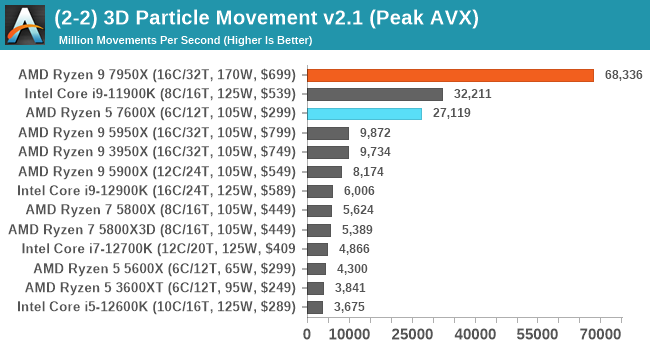
Although the use case of AVX-512 is limited to specific applications such as emulation, Ryzen 7000 and Zen 4 give users looking to utilize AVX and AVX-512 a route to do so through the desktop platforms.
AMD Ryzen 7950X: Breaking 38K in CineBench R23, New World Records
In the past, AMD has broadly used CineBench as a measure of its performance; higher core and thread counts are typically favored by rendering workloads, so it's understandable why. AMD sent us a PR around its performance with the Ryzen 9 7950X breaking 48k in CineBench R23 nT at 6.45 GHz all-core using liquid nitrogen cooling. While this is impressive, and ultimately a new world record (someone will break it quickly), this isn't entirely relevant to the masses, and we're focusing on real-world everyday performance.
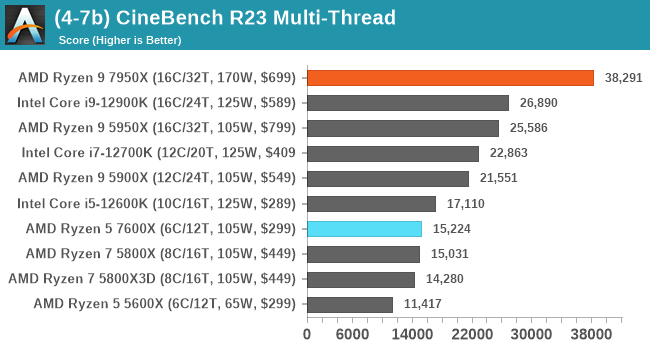
Looking at multi-threaded performance in CineBench R23, the AMD Ryzen 7950X achieved over 38K, which is undoubtedly impressive. Compared directly to Intel's Core i9-12900K, AMD is leading Intel here by around 42%, which is fantastic if you're looking for a desktop processor that's good at everything but excels in rendering workloads. By contrast, as the Ryzen 5 7600X is a 6C/12T chip, rendering performance isn't as impressive, but it's compatible with the Ryzen 7 5800X (8C/16T), which it competes with on a pretty consistent basis as per our testing for this review. That is impressive as it shows that six Zen 4 cores are roughly equal to eight Zen 3 cores.
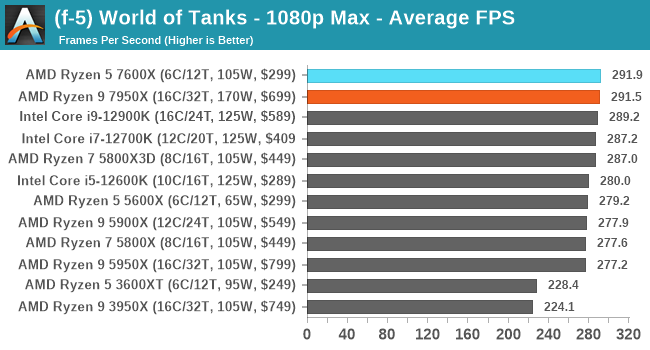
Focusing our attention on gaming performance and the improvements we are seeing in our current yet soon-to-be updated CPU gaming suite aren't as fruitful as in compute-related tasks. While the AMD Ryzen 9 7950X and Ryzen 5 7600X are competitive against other CPUs such as the Core i9-12900K in the gaming sphere, there are certainly trade-offs to consider.
Looking at our result in World of Tanks using our soon-to-be-retired NVIDIA GeForce RTX 2080ti, the Ryzen 5 7600X sits at the top at 1080p Max settings regarding average frame rates. This does show that AMD's Zen 4 core is undoubtedly powerful for gaming, even at the lower end of the product stack, such as the Ryzen 5. Ultimately, the Ryzen 7000 series is trading blows with Intel's 12th Gen Core (Alder Lake) processors across many games at various settings.
Interestingly, the previous generation Ryzen 7 5800X3D with 96 MB of 3D V-Cache is also in the mix at the top end of the gaming spectrum, and despite AMD announcing that it will be releasing a Ryzen 7000-based SKU with its 3D V-Cache packaging technology, we're unfortunately going to have to wait until next year at the earliest for this. It should make for some interesting gaming results, depending on which Ryzen series it looks to capitalize on. It will be even more interesting to see how Intel, if it can, responds in the manner that the Ryzen 7 5800X3D impacted in framerates.
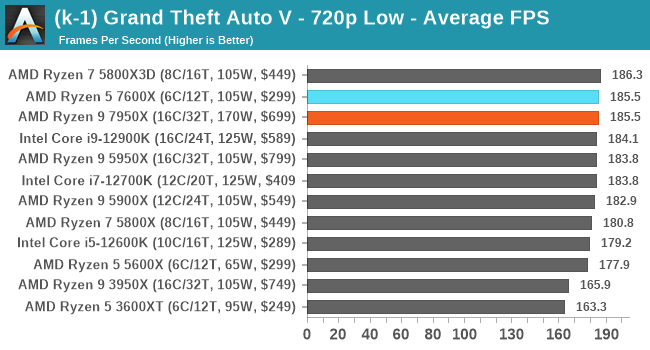
Looking at a more CPU-intensive gaming situation, such as at 720p in Grand Theft Auto V, the Zen 4 cores show their aggression in fighting the Core i9-12900K in terms of framerate. However, they are leapfrogged in this title by the Ryzen 7 5800X3D, which is expected as that processor is great in gaming but average at best in compute scenarios.
As we start to roll out our new CPU suite for 2023, which we're currently testing as we write this review, including some of the most current and latest game titles with more up-to-date graphics cards (Radeon 6950 XT), we will update our review with our findings to see how well the Zen 4 core compares to Zen 3, Zen 2, and Intel's 12th Gen Core. As it stands now, though, AMD's 5nm Zen 4 core hits a home run in compute performance compared to Zen 3 and Alder Lake, but it's more of a stalemate overall in terms of our game testing (so far).
Ryzen 9 7950X at 65 W (ECO Mode): Zen 4 has Superb Efficiency
Regarding power efficiency, AMD claims that their Zen 4 microarchitecture on TSMC's 5 nm node is its most efficient core to date. In light of this, AMD's ECO Mode allows users to adjust the processor limits through its Precision Boost Overdrive 2 settings, which have remained unchanged from the previous generation. The goal of ECO Mode is to restrict overall power with lower CPU VCore and lower current through the CPU socket (AM5) to reduce overall power consumption significantly. This also allows the Ryzen 7000 series to operate at lower temperatures, which is perfect for small form factor systems that can't fit in more aggressive CPU coolers while still benefiting from a large percentile of performance on offer.
AMD's Ryzen 7000 ECO Modes are as follows:
- 170W TDP Base = 105W with ECO Mode enabled
- 105W TDP Base = 65W with ECO Mode enabled
Going one step further than this, users can set their own package power tracking (PPT), thermal design current (TDC), and electrical design current (EDC) values into Ryzen Master or in the Precision Boost Overdrive (PBO) settings section of the firmware. AMD shared with us its recommended settings for 170 W, 105 W, and 65 W. The relevant settings for each of the main (170, 105, 65 W) TDP profiles AMD recommend are as follows:
- 170 W = 230,000 PPT, 160,000 TDC, and 225,000 EDC
- 105 W = 142,000 PPT, 110,000 TDC, and 170,000 EDC
- 65 W = 88,000 PPT, 75,000 TDC, and 150,000 EDC
Using CineBench R23 as our metric in determining how much performance loss there is on the Ryzen 9 7950X from its base TDP of 170 W down to 65 W, we are still seeing high-performance levels on both the single-threaded and multi-threaded tests.
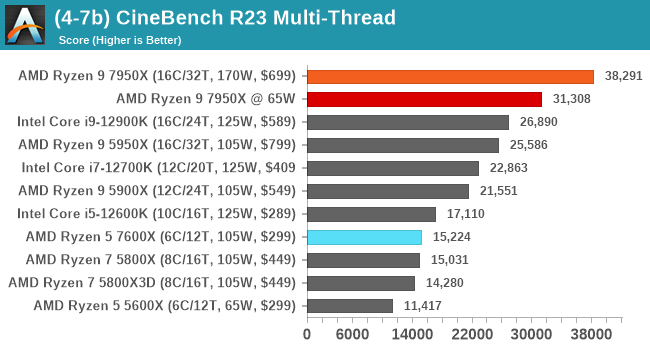
Restricting our Ryzen 9 7950X processor to just 65 W in comparison to leaving power settings untouched, the CineBench R23's multi-threaded test performance is impressive, a score of just over 31K. For comparison, the Intel Core i9-12900K only managed just under 27K at default settings, which shows that even when restricting the power proportionally down to 65 W, there's still plenty of performance available in multi-threaded situations. For reference, restricting the Ryzen 9 7950X to 65W only loses around 18-19% in CB23 MT performance; very impressive.
In the single-threaded test with CineBench R23, we only saw a drop of around 0.3%, which is negligible depending on the workload. Dropping down the overall TDP isn't as harsh on single-threaded workloads as it will be for multi-threaded workloads. ST performance remains intact mainly despite restricting overall power consumption.
The reason we used 65 W as a showcase for Zen 4's efficiency is quite simple. Restricting the power values on the Ryzen 9 7950X by around 61% (170 to 65 W) shows that the Zen 4 core is efficient and that the performance is still good. This is more relevant in small form factor systems where performance is desirable, but high heat output could impact on the longevity and performance of other components through thermal throttling.
Final Words: Zen 4 is now King, Long Live the King
Overall, when comparing AMD's new Zen 4 core to their previous Zen 3 microarchitecture, it's a big win for AMD regarding multi-threaded performance. Through the improvement of many aspects, including the switch to a higher transistor count through TSMC's 5 nm manufacturing process, higher core frequencies including both single and all-core, and the switch to DDR5 from DDR4, all of these make for a double-digit improvement to IPC performance.
| AMD Ryzen 7000 Series Processors | |||||||
| AnandTech | Cores Threads |
Base Freq |
Turbo Freq |
L2 Cache |
L3 Cache |
TDP | MSRP |
| Ryzen 9 7950X | 16C / 32T | 4.5GHz | 5.7GHz | 16 MB | 64 MB | 170 W | $699 |
| Ryzen 9 7900X | 12C / 24T | 4.7GHz | 5.6GHz | 12 MB | 64 MB | 170 W | $549 |
| Ryzen 7 7700X | 8C / 16T | 4.5GHz | 5.4GHz | 8 MB | 32 MB | 105 W | $399 |
| Ryzen 5 7600X | 6C / 12T | 4.7GHz | 5.3GHz | 6 MB | 32 MB | 105 W | $299 |
When it comes to single-threaded and multi-threaded performance, AMD takes comprehensive wins in both elements when it comes to computational workloads across the board. Although Intel's Core i9-12900K is undoubtedly a viable kit for everything, the Ryzen 9 7950X is currently the world's most powerful x86 desktop processor and delivers the performance to back it up. With an MSRP of $699, it's a cheaper insertion point than the Ryzen 9 5950X ($799) by $100, so pricing-wise, it's certainly an improvement for AMD's top-tier processor.
Touching on the Ryzen 5 7600X, this is targeted as more of an affordable processor, with similar performance levels compared to the previous generations of Ryzen 7 5800X. This in itself is an improvement, as it's essentially a 6C/12T Zen 4 processor trading blows with a Zen 3 8C/16T processor. The pricing is even more critical, as the Ryzen 5 7600X has an MSRP of just $299, making it exceptional value for money, especially from the gaming perspective. In contrast, the Ryzen 7 5800X that the 7600X trades blows with had a cost of $449 at launch back in 2020, so AMD is raising the game again in the current economic climate.
AMD has again taken the crown in overall CPU performance, so it's now Intel's turn to see how they respond. While it is expected that Intel will be retaliating in some shape or form, either that be through price cuts to its existing Alder Lake processors or the launch of its upcoming 13th Gen Core series (codenamed Raptor Lake), it has a lot of ground to make up in IPC and compute performance. At the time of writing, the AMD Zen 4 core is powerful and shows good performance efficiency at lower power levels.











205 Comments
View All Comments
AndrewJacksonZA - Monday, September 26, 2022 - link
I would imagine it's a technically correct way of saying that it's certified for Windows 11. See here about the TPM:www DOT microsoft DOT com/security/blog/2020/11/17/meet-the-microsoft-pluton-processor-the-security-chip-designed-for-the-future-of-windows-pcs/ Reply
socket420 - Monday, September 26, 2022 - link
I'm primarily asking whether or not the Pluton security coprocessor has been incorporated into Raphael/Ryzen 7000 CPUs, and I'm pretty sure that isn't what they were implying - Microsoft *does* have a "secured-core PC" baseline for Win11 they've been pushing lately, but it's currently unclear how Pluton ties into that so I don't think Win11 "certification" has anything to do with it. Pluton wasn't mentioned in AMD's desktop Ryzen 7000 press release last month, I didn't see it in any of the Zen 4 architectural slides they showed off today and AnandTech is the only outlet that's brought it up at all, which is why I'm asking this question in the first place - AMD hasn't been particularly forthcoming about the subject and I feel like they would've mentioned Pluton in a press release if it was actually present in these chips. ReplyRyan Smith - Monday, September 26, 2022 - link
I am not privy to the implementation details. But like other parts of the IOD, Pluton is inherited from the Ryzen 6000 Mobile parts. So it has the same Pluton implementation as those mobile chips.TL;DR: I don't know how they're technically accomplishing it, but yes, Pluton is there and enabled. Reply
socket420 - Tuesday, September 27, 2022 - link
Thanks for the response. Just to clarify, if I reread that section correctly, the Ryzen 7000 I/O die is a new design that had most of the additions from Ryzen 6000 ported over to it, Pluton included. That sounds incredibly damning, but I'm not sure how it's possible to confirm its presence without implementation details. I'm also unsure why AMD would brag about Pluton being present in two different mobile CPU releases from the moment they were announced while seemingly ignoring it in their new and shiny desktop Ryzen lineup up until its release date (are they hoping we won't notice?), but then again, it's been months since Ryzen 6000 was launched and no one's taken a closer look at its Pluton implementation yet, so :/IIRC, Lenovo ships their Ryzen 6000 Thinkpads with Pluton disabled and you have to go into their BIOS to toggle it on or off, so maybe that option showing up on consumer AM5 boards will show us if Pluton's there or not? It'd also be cool if someone asked AMD directly for a response, but Robert Hallock said he "didn't know" if Pluton was in Zen 4 and he coincidentally just left the company, so I have no idea who to reach out to. Reply
Silver5urfer - Tuesday, September 27, 2022 - link
Thanks for your question and this new garbage Pluton cancer is what I did not want to see shame how they added it. ReplyOxford Guy - Tuesday, September 27, 2022 - link
You will own nothing and be owned by everything. You will be happy. ReplyValantar - Monday, September 26, 2022 - link
Could you please run your per-core power draw tests for these chips like you did for Zen3? Replytakling1986 - Monday, September 26, 2022 - link
I think this review is "streets ahead". ReplyIBM760XL - Monday, September 26, 2022 - link
All right, since they aren't read yet, I'll ask... is it easy to set a lower TDP limit, and could you examine power efficiency when the TDP is the same as it was for Ryzen 5000?Looking at the numbers Tom's Hardware posted, the 7950X uses about 80W more at load than the 5950X. With AMD's own slides touting the efficiency improvements being greater at lower TDPs, what I'd really like is to have an octo-core at 65W like the 5700, or perhaps a 12/16 core at 105W like the 5900/5950.
Though I'm very likely to wait until B650 drops before making a decision, so there's plenty of time for an answer to that question to arrive. Reply
abufrejoval - Wednesday, September 28, 2022 - link
I can only guess that it should be trival to do via RyzenMaster, just in case it's not supported in the BIOS. And of course I'd demand CLI tools for both Linux and Windows.I cannot imagine that with a max TDP of 140 Watts a 7950X won't still be faster than a 5950X, even if it won't be quite as fast as if you let it drain the bottle at full hilt. The typical CMOS knee will still be there, only moved forward a bit and with a lot more of a "hot leg" showing towards the top.
But gains per clock and Watt will be terrible the higher you go on the "hot leg" by nature of silicon physics and any sensible person will just use a "lesser cooler" to avoid that nonsense. Reply